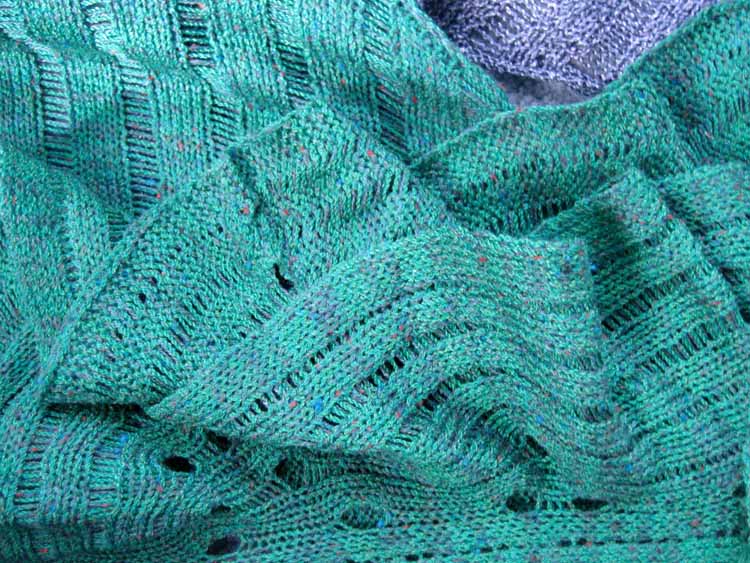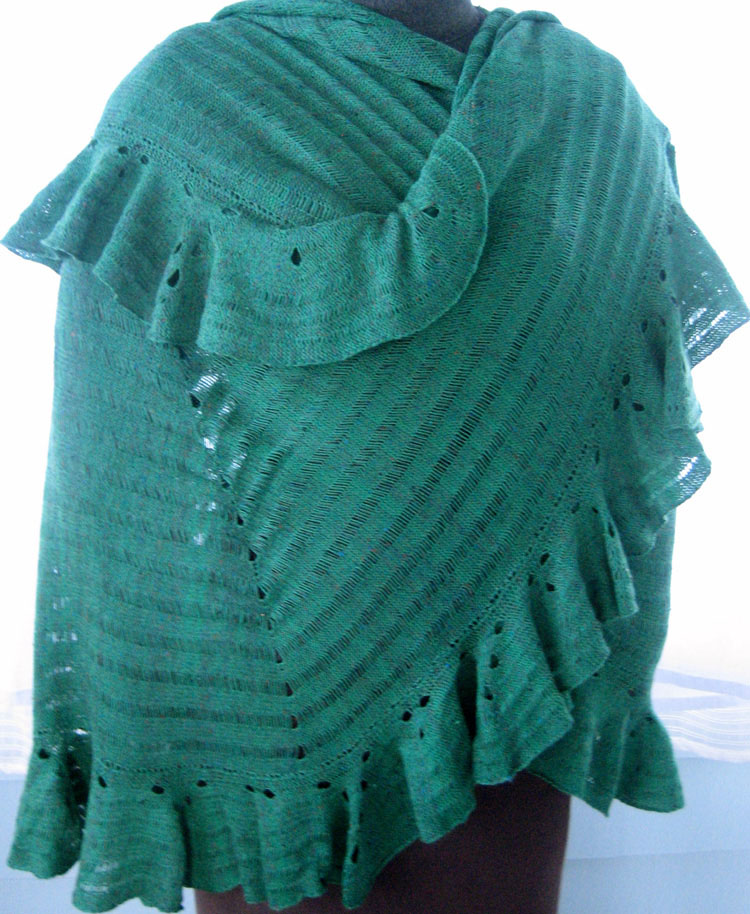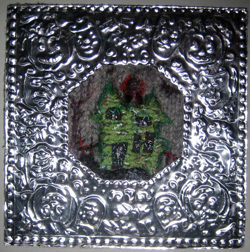as it appears at the end of knitting
on the blocking board
it is done!
When I taught, I felt the need to come up with a “clean’ expletive for moments that simply required one, mine was “figlet”. With nearly 60 inches of shawl knit, this “magically” happened.
I now have about 120 + rows of carriage transfers and knitting to undo to get back to a place I can hopefully repair/continue from. Am trying to convince myself it will be a meditative undertaking. Happiness is not doing this type of knitting for a day job: double figlet!
The lace pattern used in the last shawl is now reworked to eliminate hand transfers required on every other pair of knit rows. A second shawl using the new version is in progress.
Some random tips after the journey so far come to mind.
KM: Brother 910 with mylar sheets:
For marking the mylar the Mirado Black Warrior HB2 pencil used on its reverse side produces good results for reader scanning.
It is helpful to have oiled, clean carriages: Hoppe’s elite gun oil (no silicone) rather than sewing machine or brother oils is safe for plastics, for use on Passap beds, and is the only thing I now use on my machines.
Dropped stitches can abound, checking gate pegs, needle latches and their condition can help prevent some of them. Familiarizing oneself with yarn and visually checking after each transfer row may actually save time in the long run.
I have had moments where I felt like Penelope undoing her work 24/7. If rows of stitching need to be unraveled it is easier to undo transfers before the unraveling, and repeats sometimes are corrected more easily if taken back to the beginning of the transfer sequence.
The lace carriage must be taken beyond needle selection marks at either end of the machine prior to any “correction” to prevent selection errors.
If more than one lace pattern is on the mylar sheet the lace column or an alternate can be marked with colored pencils with different colors assigned to each pattern repeat.
This baby blanket was a double bed knit on a Passap machine, inspired by the woven patterns found in early American coverlets. Blue, red, and white are in use. Because of the knitting technique as colors knit one at a time the alternate colors “bleed through”, giving the illusion of more or even different colors.
After hand washing the piece, blocking wires and pins were used to help it retain desired shape while drying. Its final measurements in inches are 20W by 68L, its weight 3.25 oz. Steaming alone helped stabilize stitches for corrections and is often enough for many pieces in terms of blocking, but flattened the surface excessively in this case. Texture returned and became more apparent with the use of the former method. In the image below the center, pivoting point of the mirrored pattern is evident.
The first half of the shawl as it appears on the machine in the process of being knit after several false starts. Gaping holes were typical of potential stitch “drops”. Yarn was knit at loose tension for the effect, in turn resulting in gate peg issues at intervals, but tolerated the lace transfers and hook up problems without breaking, an absolute necessity in a piece such as this. Studio brand ribber comb provided the best source of even weight.
MacKnit was a very short lived American machine knitting magazine (1980s). In Number 5, beginning on page 40, Susanna published a lace shawl pattern that included several transfer lace types. Garment shaping was achieved through an intriguing series of triangles joined during the knitting of them. Using her lace graphs, so far I have the resulting swatches below. There are 2 errors I need to sort out; the fabric is intriguing. The top pattern rows become the triangular edging. The yarn that finally “worked” for me was the Valley Yarns 2/14 Alpaca Silk blend from Webs.
The swatches were very quickly steamed. Lace is one of those fabrics that actually require “real” blocking for best results. Some hand-tooling is mixed in the repeats, stitch formation needs to be constantly checked. Will sort out problem areas, then see where that takes me while keeping any first project as simple as possible.
Winter inventory was completed long ago. I live in the northeast which has had a notoriously snowy winter. Many an hour has been spent in snow removal, few hours knitting anything “new”. I have completed some hand knitting projects, and as one, I attempted re-knitting a lace shawl successfully completed multiple times before. Having trouble tracking its complicated pattern, I journeyed back to taking “another look” at machine knit lace. Multiple transfer lace on the machine can be slow, tedious, and requires patience in the original setup, as one must have yarn that tolerates transfer across fixed metal parts without breaking and the “perfect” weight to allow stitches to knit off properly. Though I like designing my own stitch patterns this is not anything I am ready to do in lace.
The first foray in my explorations resulted from a discussion on a knitting yahoo group I belong to with regards to a lace chart published at redlipstick.net (website was later deleted).
Below are images of the resulting fabric:
purl side  knit side
knit side
Blocking is one of those knitting preferences that can arouse strong pro/con arguments, and goes the range from casual to nearly compulsive with wires, pins, and assorted tools used to achieve desired results. My shawls continue to sell well: the photos below illustrate part of the process and 2 of the most recent in their family. All shaping and joining are achieved through the knitting process; the shawls are reversible, may be worn and draped in a variety of ways.
before steaming and pressing

detail shot after steaming/pressing

one way to wear, purl side facing out

My first “fiesta” ornament with some mood lighting (frame is actually bright embossed aluminum), 4.25-inch square